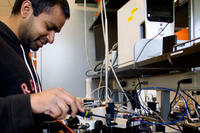-
New rapid diagnostic test for pathogens, contaminants developed
Using nanoscale materials, researchers have developed a single-step method rapidly and accurately to detect viruses, bacteria, and chemical contaminants; the method could be used to detect pathogens and contaminants in biological mixtures such as food, blood, saliva, and urine
-
-
Bomb threat? There’s an app for that

In the first chaotic moments after suspicion of a bomb threat, first responders have a myriad of questions, assessments, and decisions to make, all at once, and all the while the scene could be changing rapidly: Is the bomb real? How large is the potential blast radius? Where will we evacuate people? Are there any critical infrastructure or special-needs population centers in the vicinity? Any schools, hospitals nearby? What roads should be closed? Which roads should stay open for evacuees? There are many more questions, many more uncertainties; DHS Science and Technology Directorate (S&T) and its private sector partners have now developed a must-have app: the First Responder Support Tools (FiRST) for computers and smartphones
-
-
New method uses gunshot residue to determine caliber, type of weapon used in crime
Researchers have developed a method to determine the caliber and type of weapon used in a crime by analyzing gunshot residue (GSR); using near-infrared (NIR) Raman microspectroscopy and advanced statistics, the new technique may play a pivotal role in law enforcement cases and forensic investigations
-
-
Saab shows new CBRN detection system
Saab introduces a new concept in CBRN detection: a CBRN detection and warning system designed for use by non-specialists in the field
-
-
New DNA-based chemical sensor acts as an all-electronic nose
Chemical sensors are very good at detecting a single substance or a class of chemicals, even at highly rarified concentrations; biological noses, however, are vastly more versatile and capable of discriminating subtle cues that would confound their engineered counterparts; even highly trained noses, however, do leave a certain ambiguity when relaying a signal
-
-
Smart gas sensors offer better chemical detection

Smart chemical sensors can detect chemical weapon vapors or indicators of disease better than the current generation of detectors; they also consume less power, crucial for stretching battery life on the battlefield, down a mineshaft, or in isolated clinics
-
-
Naturally occurring enzyme to defend against chemical terrorism
Today, protection against nerve agents relies primarily on physical barriers such as gas masks and protective suits that can easily be breached; following exposure, people are treated with drugs that help with the symptoms but do not eliminate the nerve agent; researchers hope to change this, relying on the principles of evolution to produce a more efficient version of an enzyme that occurs naturally in all of us
-
-
MRIGlobal awarded $9 million to evaluate detection gear
Kansas City company in a $9 million contract with the U.S. Army to test and evaluate equipment to identify chemical, biological, and radiological hazards in the field
-
-
Researcher develops highly sensitive, nanomaterial gas detector
A doctoral student at the Rensselaer Polytechnic Institute has developed a new sensor to detect extremely small quantities of hazardous gas
-
-
Universal Detection unveils radiation detection smartphone app
Last week Universal Detection Technology unveiled its first generation smartphone app designed to detect nuclear radiation levels on a variety of surfaces including food
-
-
New paper gas detectors developed
Researchers at the University of Michigan, Ann Arbor, have developed a quick and simple way to detect the presence of nerve gases
-
-
End of Utah’s chemical weapons stockpile signals end of federal grants

As the last of Utah’s chemical weapons stockpile is destroyed, the millions of dollars that have flowed into the state from federal grants will begin to disappear along with thousands of jobs
-
-
New technology will allow miniaturization of chemical sensors
A new measuring technology – based on measuring near-resonant nonlinear behaviors rather than measuring chemomechanically induced shifts in linear natural frequency – will allow a dramatic miniaturization of sensors; the miniaturization will make these sensors more suitable for first response, law enforcement, and military missions
-
-
Inspectors uncover Qaddafi’s hidden WMD stockpile
Last week international weapons inspector found clear evidence that the late Libyan dictator Moammar Qaddafi had large caches of hidden chemical weapons, despite making a promise to destroy all weapons of mass destruction weapons in 2004
-
-
Smiths Detection unveils new portable chemical detector
Earlier this month Smiths Detection unveiled its latest chemical detector, a portable device that combines high speed, high-resolution gas chromatography and a miniaturized toroidal ion trap mass spectrometer
-
- All
- Regional
- Water
- Biometrics
- Borders/Immig
- Business
- Cybersecurity
- Detection
- Disasters
- Government
- Infrastructure
- International
- Public health
- Public Safety
- Communication interoperabillity
- Emergency services
- Emergency medical services
- Fire
- First response
- IEDs
- Law Enforcement
- Law Enforcement Technology
- Military technology
- Nonlethal weapons
- Nuclear weapons
- Personal protection equipment
- Police
- Notification /alert systems
- Situational awareness
- Weapons systems
- Sci-Tech
- Sector Reports
- Surveillance
- Transportation
Advertising & Marketing: advertise@newswirepubs.com
Editorial: editor@newswirepubs.com
General: info@newswirepubs.com
2010-2011 © News Wire Publications, LLC News Wire Publications, LLC
220 Old Country Road | Suite 200 | Mineola | New York | 11501
Permissions and Policies
Editorial: editor@newswirepubs.com
General: info@newswirepubs.com
2010-2011 © News Wire Publications, LLC News Wire Publications, LLC
220 Old Country Road | Suite 200 | Mineola | New York | 11501
Permissions and Policies
